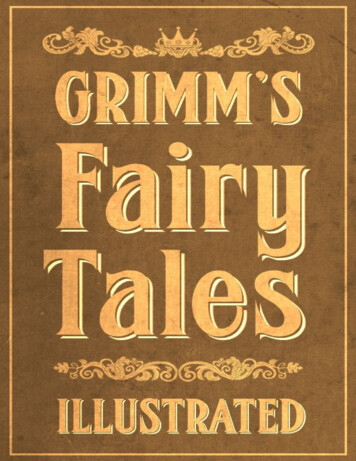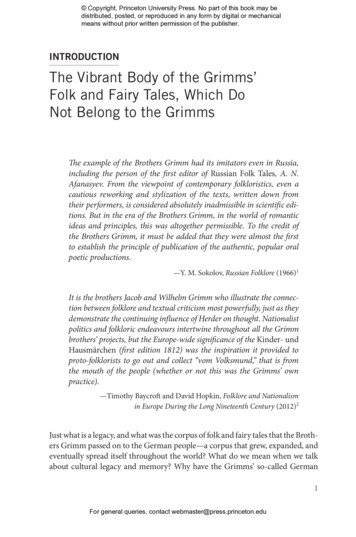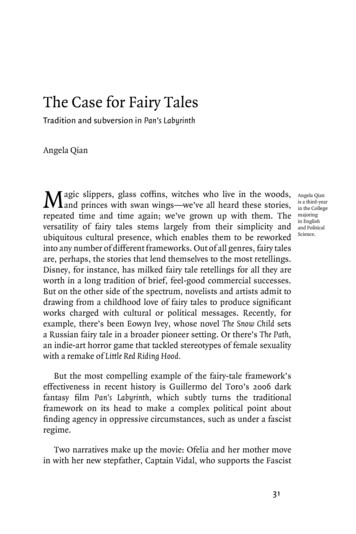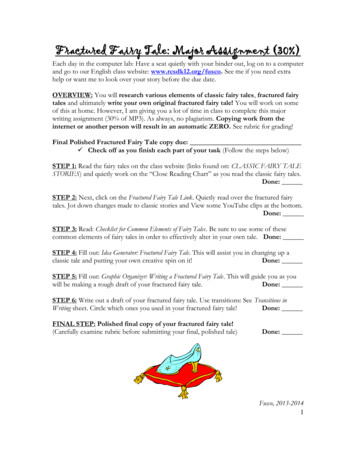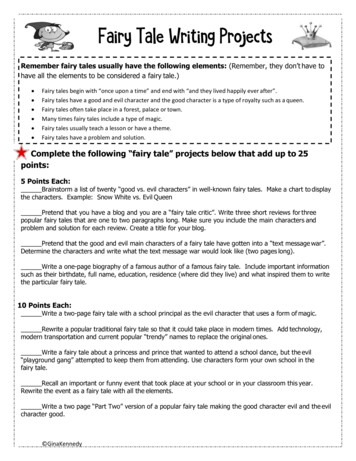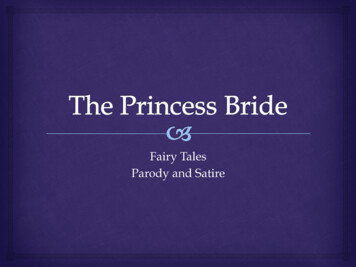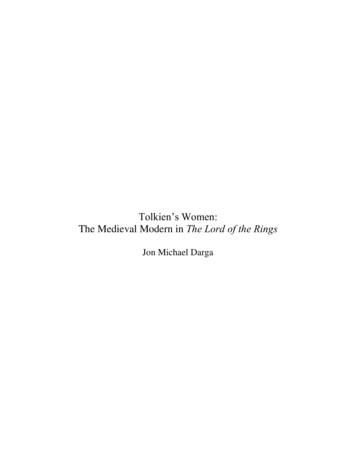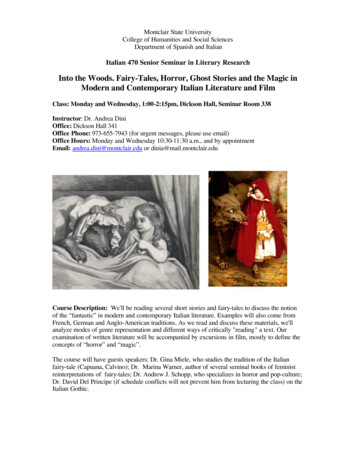
Transcription
Issue201344Gender and Fairy TalesEdited byProf. Dr. Beate NeumeierISSN 1613-1878
EditorAboutProf. Dr. Beate NeumeierGender forum is an online, peer reviewed academicjournal dedicated to the discussion of gender issues. Asan electronic journal, gender forum offers a free-ofcharge platform for the discussion of gender-relatedtopics in the fields of literary and cultural production,media and the arts as well as politics, the naturalsciences, medicine, the law, religion and philosophy.Inaugurated by Prof. Dr. Beate Neumeier in 2002, thequarterly issues of the journal have focused on amultitude of questions from different theoreticalperspectives of feminist criticism, queer theory, andmasculinity studies. gender forum also includes reviewsand occasionally interviews, fictional pieces and poetrywith a gender studies angle.University of CologneEnglish DepartmentAlbertus-Magnus-PlatzD-50923 Köln/CologneGermanyTel 49-(0)221-470 2284Fax 49-(0)221-470 6725email: gender-forum@uni-koeln.deEditorial OfficeLaura-Marie Schnitzler, MASarah Youssef, MAChristian Zeitz (General Assistant, Reviews)Tel.: 49-(0)221-470 3030/3035email: gender-forum@uni-koeln.deEditorial BoardProf. Dr. Mita Banerjee,Johannes Gutenberg University Mainz (Germany)Prof. Dr. Nilufer E. Bharucha,University of Mumbai (India)Associate Prof. Dr. Carmen Birkle,Philipps-Universität Marburg (Germany)Prof. Dr. Ingrid Hotz-Davies,Eberhard Karls University Tübingen (Germany)Prof. Dr. Ralph Poole,University of Salzburg (Austria)Prof. Dr. Kathryn Schaffer,University of Adelaide (Australia)Prof. Dr. Chris Weedon,Cardiff University (UK)Editorial DeadlinesSpring Issue:abstracts (October 1),completed papers (January 1)Summer Issue:abstracts (January 1),completed papers (April 1)Fall Issue:abstracts (April 1),completed papers (July 1)Early Career Researchers Special Issue:abstracts (May 1),completed papers (August 1)Winter Issue:abstracts (July 1),completed papers (October 1)Opinions expressed in articles published in gender forumare those of individual authors and not necessarilyendorsed by the editors of gender forum.SubmissionsTarget articles should conform to current MLA Style (8thedition) and should be between 5,000 and 8,000 words inlength. Please make sure to number your paragraphsand include a bio-blurb and an abstract of roughly 300words. Files should be sent as email attachments in Wordformat. Please send your manuscripts to genderforum@uni-koeln.de.We always welcome reviews on recent releases inGender Studies! Submitted reviews should conform tocurrent MLA Style (8th edition), have numberedparagraphs, and should be between 750 and 1,000words in length. Please note that the reviewed releasesought to be no older than 24 months. In most cases, weare able to secure a review copy for contributors.Article PublishingThe journal aims to provide rapid publication of researchthrough a continuous publication model. All submissionsare subject to peer review. Articles should not be underreview by any other journal when submitted to Genderforum.Authors retain copyright of their work and articles arepublished under a Creative Commons licence.There are no submission or page charges, and no colourcharges.
Detailed Table Of ContentsEditorial1Baiqing Zheng: From Courtly Love to Snow White3Nancy Taber: Detectives and bail bonds “persons” as fairy tale hero/ines: Afeminist antimilitarist analysis of Grimm and Once Upon a Time13Annette Schimmelpfennig: Chaos Reigns: Women as Witches in ContemporaryFilm and the Fairy Tales of the Brothers Grimm28Caleb Sivyer: A Scopophiliac Fairy Tale: Deconstructing Normative Gender inAngela Carter’s “The Bloody Chamber”45Shu-Ju Ada Cheng (Review): “Tacit Subjects: Belonging and Same-Sex DesireAmong Dominican Immigrant Men.”62List of Contributors65
Editorial1This issue of Gender Forum is dedicated to the discussion of gender and how it isimpacted by and reproduced in fairy tales. The influence that fairy tales have on our culture isindisputable even today – the Grimms’ tales remain present in children’s bedrooms in theshape of Disney movies, and many cultural tropes, from the evil stepmother to the potionbrewing witch, have their foundation in fairy tales. The contributors to this issue haveexamined a wide variety of diverse texts – from Angela Carter’s short stories tocontemporary TV series – to trace the continued cultural impact of fairy tales in relation toconstructions of gender and sexuality.2The first contribution, “From Courtly Love to Snow White”, comes from BaiqingZheng. She draws parallels between chivalric romance and modern re-writing of fairy tales,both of which involve the agonies of unfulfilled love. Rather than providing a happily-everafter ending, the relations between the heroes and heroines are often complicated by twists,suspension, revelation, confusion and subversion. Zheng traces these themes in short storiesby Robert Coover and Angela Carter, as well as poetry by Anne Sexton and concludes thatthese revisions of “Snow White” draw a parallel between women in love and women inlanguage, and are committed to disenchanting the constructed feminine myth.3In her article “Detectives and bail bonds ‘persons’ as fairy tale hero/ines: A feministantimilitarist analysis of Grimm and Once Upon a Time”, contributor Nancy Taber exploresthe re/writing of gendered scripts in the television programs Grimm and Once Upon a Time.Using a feminist antimilitarist framework in her examination of these modern retellings offairy tales, she argues that gender, violence, and militarism are represented in complex waysthat variously position ideas of good and evil, protected and protector, masculinity andfemininity through the programs' characterizations of heroic hunters and saviours who arealso estranged mothers and sons.4Contributor Annette Schimmelpfenning in her article “Chaos Reigns – Women asWitches in Contemporary Film and the Fairy Tales of the Brothers Grimm” makes anargument for the versatility and changeability of the figure of the witch. Starting with ananalysis of the construction of the witch in fairy tales, she traces her development through theages up to her inclusion in modern Hollywood film. Highlighting different types of witches,Schimmelpfennig shows how in all her different manifestations the witch is, above all,always both reflective of and a contributor to persistent tropes of femininity.1
5Lastly Caleb Sivyer, in his article “A Scopophiliac Fairy Tale: DeconstructingNormative Gender in Angela Carter’s ‘The Bloody Chamber’”, illuminates Carter's rewritingof Bluebeard with a focus on the visual. He argues that Carter takes up the flexible structureof the fairy story in order to communicate the experiences of being a woman in a patriarchalsociety, subjected to certain ways of seeing and being seen.6The issue is rounded off with a review by Shu-Ju Ada Cheng, who writes about the2011 publication of Tacit Subjects: Belonging and Same-Sex Desire Among DominicanImmigrant Men by Carlos Ulises Decena. The book, based on academic research as well aspersonal interviews, examines the ways in which gay and bisexual male immigrants fromDominica to New York dealt with the multiple levels of oppression and stigmatization theywere faced with.2
From Courtly Love to Snow WhiteBy Baiqing Zheng, University of International Business and Economics, ChinaAbstract:In chivalric romances, courtly love often entails the love between a single knight and amarried woman. This love cannot be consummated in a physical sense and, if it is, disasterand death ensue. Courtly love therefore involves the agonies of unfulfilled love. What Lacanfinds of interest in these chivalric romances is its symbolic aspect. The poetic exercise ofcourtly love raised by Lacan has various manifestations in Robert Coover’s “The DeadQueen”, Anne Sexton’s “Snow White” and Angela Carter’s “The Snow Child”, threecontemporary revisions of the classical fairy tale “Snow White”, where the conventionalutopia ending of “Prince and Princess live happily ever after” is rarely seen. Instead, twists,suspension, revelation, confusion and subversion often accompany the plots, and complicatethe relations between heroes and heroines, which can find equivalents of idealizing themes incourtly love. These three revisions of “Snow White” draw a parallel between women in loveand women in language, and are committed to disenchant the constructed feminine myth.1In chivalric romances, courtly love embodies a whole philosophy of love andrepresents an elaborate code of behavior which governs the relations between ‘aristocratic’lovers, turning the more bodily and erotic aspects of love into a spiritual experience and themost elevated form of passions. The courtly lover both idealizes and is idealized by hisbeloved and subjects himself entirely to her desires. However, there is an inherentimpossibility, an obstacle to the fulfillment of love, in the very structure of courtly love. As itdevelops, courtly love often entails the love between a single knight and a married woman.This love cannot be consummated in a physical sense and, if it is, disaster and death ensue.Courtly love therefore involves the agonies of unfulfilled love, but the lover remains true tohis beloved, manifesting his honor and steadfastness in an unswerving adherence to the codeof behavior. What Lacan finds of interest in these chivalric romances is its symbolic aspect.Courtly love is “a poetic exercise, a way of playing with a number of conventional, idealizingthemes, which couldn’t have any real concrete equivalent” (148). This poetic exercise ofcourtly love raised by Lacan has various manifestations in Robert Coover’s “The DeadQueen”, Anne Sexton’s “Snow White” and Angela Carter’s “The Snow Child”, threecontemporary revisions of the classical fairy tale “Snow White”, where the conventionalutopia ending of “Prince and Princess live happily ever after” is rarely seen. Instead, twists,suspension, revelation, confusion and subversion often accompany the plots, and complicatethe relations between heroes and heroines, which can find equivalents of idealizing themes incourtly love. It draws a parallel between women in love and women in language. In bothcases their role is metaphoric. These three revisions of “Snow White” acknowledge the power3
that such a metaphor has had, while on the other hand is committed to disenchant theconstructed feminine myth.The Lady of Inaccessibility2Just as Hélène Cixous claims that all mystery emanates from women being beautiful,but passive, hence desirable, “sublimation” is the word to describe the mystic lady in courtlylove. In The Ethics of Psychoanalysis, Lacan’s fundamental definition of Sublimation is aprocess which “elevates an object to the dignity of the Thing (la Chose)” (152). Lacan laterclaims that la Chose has the character of an au-dela du sacre. From this point of view, theexemplary form or paradigm of Sublimation would be courtly love, which is dependent uponthe very inaccessibility of its object. However, the first trap to be avoided apropos of courtlylove is the erroneous notion of sublimation, of the Lady as the sublime object: as a rule, oneevokes here spiritualization, a shift from the object of raw sensual coveting to elevatedspiritual longing—the Lady is thus perceived as a kind of spiritual guide into the highersphere of religious ecstasy, somehow in the sense of Dante’s Beatrice. However, Lacanemphasizes a series of features which belie such spiritualization. Lacan admits that theinaccessible lady itself is actually anything but sublime: “By means of a form of sublimationspecific to art, poetic creation consists in positing an object I can only describe as terrifying,an inhuman partner” (150). That means this abstract character of the Lady has nothing to dowith spiritual purification; it rather points towards the abstraction that pertains to a cold,distanced, inhuman partner.3In “Courtly Love, or, Woman as Thing,” Slavoj Žižek pushes forward Lacan’sstatement: “This surface functions as a kind of ‘black hole’ in reality, as a limit whoseBeyond is inaccessible” (91). The Lady is an impossibly idealized figure. “The objectinvolved, the feminine object, is introduced oddly enough through the door of privation or ofinaccessibility. Whatever the social position of him who functions in the role, theinaccessibility of the object is posited as a point of departure” (149). “The lady as a mirrorfulfills a crucial role, a role as limit. It is that which cannot be crossed” (151). Human isperpetually in a state of desire, the desire to perpetually delay, distance and defer thesignifier. That is, the object of desire cannot be possibly got, otherwise it cannot be desired.Courtly love inscribes the inaccessibility as the proper form of relation between man andwoman. Žižek also points out the erroneous notion of sublimation, of the Lady as the sublimeobject apropos of courtly love. It should be clear in what precisely consists the differencefrom the usual dialectic of desire and prohibition: the aim of the prohibition is not to ‘raise4
the price’ of an object by rendering its access more difficult, but to raise this object itself tothe level of the Thing, the ‘black hole’ around which desire is organized. (Žižek 92) It is thenecessity of perpetually sustaining desire at the cost of fulfillment. The history of reading isthe history of desire. It is human compulsion to read obscure object of desire, the emptycenter. Thus the inaccessibility makes the object sublime. It is never the happy ending incourtly love when the pursued lady condescends to the knight’s courtship. Once desire isfulfilled, void and loss follow.4Robert Coover’s short novel “The Dead Queen”, a contemporary revision of theclassical fairy tale “Snow White”, is a vivid illustration of the concept of courtly love raisedby Lacan and Žižek. It is a story about desire and perpetual diffêrance (to use the word fromDerrida), and Snow White therein acts as a lady of inaccessibility. The prince who has justmarried Snow White the day before and now is gazing speculatively at her dead stepmotherin the glass coffin, which once contained his wife, retells the novel in flashbacks. In a quasiexistentialist and reflective mode, the prince supplements the tale, as we know it withunexpected details from his magic wedding night and with a new episode at the gravesite. Inthis retelling, the most traumatic moment comes in the prince’s wedding night, which is aperfect variation of the theme of “courtly love”: After having an overwhelmingly ecstaticnight with Snow White on the wedding night, the prince waked to find “the bed unmussedand unbloodied, her hymen intact” (Coover 312). She is a representation of Bakhtin’sclassical body: a “smooth” and “impenetrable surface” that situates itself as “a separate andcompleted phenomenon” in terms of both image and the story that is intertextually invokedby the image (318). Paradoxically, the prince has the desire fulfilled and meanwhile it doesnot violate the law of the inaccessibility of the object, the limit and the “black hole.” He findsa perfect balance in this seeming oxymoron or rather a utopian vision. Since it is the nature ofunconsciousness to feed on desire, on lack, the chance is that after sexual ecstasy all is voidand nothingness, and therefore men are eager for the original stage of irreversible wholenessand intactness. Men are fascinated by the myth of virginity, the virgin land no one has everreached, accessed or explored:A virgin body has the freshness of secret springs, the morning sheen of an unbrokenflower, the orient lustre of a pearl on which the sun has never shone. Grotto, temple,sanctuary, secret garden—man, like the child, is fascinated by enclosed and shadowyplaces not yet animated by any consciousness, which wait to be given a soul: what healone to take and to penetrate seems to be in truth created by him. (Beauvoir 311)5
5Virginity is one of the secrets that men find most exciting in that the girl’s purityallows hope for every kind of licence, and no one knows what perversities are concealed inher innocence. Women’s ambiguity is just that of the concept of the Other. The Other is evil,yet necessary to the Good. Is Snow White Angel or Demon? Her uncertainty makes her aSphinx in the Prince’s eyes, and Sphinx is also commonly represented as a woman. We findthis fascinating combination and magic resolution in Snow White in Coover’s version. Themagic, unbreakable hymen makes Snow White a limit, the Thing whose Beyond isinaccessible despite the real or fantasized intercourse. Beauvoir thus concludes: “She iseverlasting deception, the very deception of that existence which is never successfullyattained nor fully reconciled with the totality of existents” (323).6At the wedding, the prince is troubled by the true meaning of bride’s name. Theprince’s questions about Snow White challenge the truthfulness of the process of femaleinitiation as the traditional tale presents it, and ask us to re-examine the meaning of her name.Marriage, which plays an important role in folktales—particularly if they are tales of femaledevelopment—is certainly a climactic moment of revelation in “The Dead Queen,” but itdoes not function as a symbolic reconciliation of oppositions which arise out of social andpsycho-sexual conflicts. Rather, it intensifies differences and magnifies the “frozen” andideological nature of Snow White as a metaphor. Consequently, Snow White is exposed as anempty and frozen signifier: completing the cycle of initiation always involves a loss, whileSnow White has “suffered no losses, in fact that’s just the trouble, that hymen can never bebroken, not even by me (the prince), not in a thousand nights, this is her gift and essence”(53). She is cold, distanced, inhuman, inaccessible from outside, and corrupted from within,as the Prince meditates: “I could vouch for her hymen from this side, but worried that it hadbeen probed from within” (52). She is static, she is always there, and because of it, she cansee neither fore nor aft. She is the Other, she is other than herself, other than what is expectedof her, and other than what she should be. She is in no way a warm, compassionate,understanding fellow-creature. She is a hazy enigma. The perplexity of her being rejects thePrince’s decoding. If the Lady of courtly love can be said to act as a mirror upon which themale lovers project their idealized images and fantasies, then this can only take place if themirror is there already. In other words, she is exactly the kind of figure that one can have noempathetic relationship with whatsoever.7In order to be Snow White whose image the mirror reflects and cherishes, she must beparadoxically denied the normalizing process of growth the tale overtly proposes; if SnowWhite were to become “whole” and experience her sexuality as reproduction, she would6
undoubtedly become like her stepmother. Thus, in order to preserve the wholeness andinnocence of Snow White, she becomes a unified subject who cannot grow or change,reflected in her impenetrable hymen, inaccessible virginity and unbroken femininity. Thispatriarchy’s ideal daughter is actually a phallic construct. Coover’s tale confronts us with theideological, and therefore entropic, nature of the metaphor: to conform to a humanistauthoritative idea of what woman “is,” Snow White is condemned to be a heartless andunconscious child who cannot change, a unified subject who cannot grow. She is as “dead” asthe dead queen. In bed with his bride, the prince gazes “into the mirror to see, for the firsttime, Snow White’s paradigmatic beauty” (310). It is significant that only through the mirrorcan the prince find out the essence of Snow White. Since the mirror reflects the patriarchalgaze, it reveals the prince’s complicity with that ideology in defining woman as‘paradigmatic beauty,’ even without his own consciousness. The Queen has lived and died infull awareness of the authority of the mirror, while Snow White has been unconsciouslyframed by it, and she is frozen into an aesthetic object erotically gazed by the mirror. Puzzledby Snow White’s passionate and anything but innocent lovemaking and then by therealization that her hymen cannot be broken, the prince is moved to believe that the evilqueen has plotted the whole story to free herself from the mirror. Through the use of a selfconscious and inquisitive narrator, Coover uncovers the ideological implications of sexualand narrative production in the tale of “Snow White”.Woman as Thing8The tendency to reduce a woman to an aesthetic object, inert and passive, contributestowards the dehumanization of women as Thing. Men are fascinated and enchanted by cold,freezing, static and silent female body as art, object and the Other. Even if women are not likean object, men make them “perform,” to use Judith Butler’s term, in an artificial way tosatisfy their desire. It is actually a highly symbolic act which signifies women’s existentialcondition under male erotic gaze. Man’s pursuit of woman leads him to the love, worship andelevation of woman as Thing. The male gaze is constructed according to structures of controlinscribed by sadistic voyeurism and / or fetishistic scopophilia (looking as a source ofpleasure). In Laura Mulvey’s seminal essay “Visual Pleasure and Narrative Cinema,” shegave fresh impetus to the debate about the male gaze and voyeurism, masculinity, power andsubordination. Mulvey employed Lacanian psychoanalysis to analyze how the cinematic gazeis organized like a language, according to patriarchal codes and conventions, where7
masculinity is empowered through the act of looking, while femininity is disempowered bybeing reduced to passively being looked at.9In Woman Hating (1974), one of the most aggressive fairy-tale critiques, theAmerican radical feminist Andrea Dworkin focuses on Snow White and Sleeping Beauty asthe embodiments of passive beauty: “For a woman to be good, she must be dead, or as closeto it as possible” (42). The Brothers Grimm, gazing at Snow White through the prince’s eyes,seems to be fascinated by the beauty in the coffin, cold and dead. Snow White, or rather herbody, becomes the prototype of passive, cold and distant woman without desire, butfunctioning as a mirror projecting man’s desire. Snow White is the impossible andinaccessible object of desire that inaugurates the movement of desire itself. In “The DeadQueen,” the Queen is regarded as a vicious monster when she is alive, but once she is dead,she has the dim possibility of mimicking Snow White in the coffin and arousing male desire.The dead Queen in the coffin is just like the former “dead” Snow White, sublimed or rather“debased” to be Thing.10In Anne Sexton’s poem “Snow White” collected in Transformations, Snow White isdescribed as an artifact, a doll, a “plucked daisy,” a dumb bunny, an Orphan Annie (makingthe dwarfs “wise / and wattled like small czars”). This poem is preceded by a prologue onvirginity which provides both context and interpretative clues for the ensuing tale. The word“virgin” in this poem does not have the “great primal sense of the word” it has for AdrienneRich, denoting “the woman who belongs to herself” (Rich 96). “The virgin” is, rather, acommodity prized by men, whose voices blend to create the persona of the speaker of theprologue. We meet the huckster who calls her a “lovely number,” the connoisseur whoitemizes her features in terms of fine tobacco, porcelain, and wine, the pimp who points outthat she is “unsoiled,” and the sportsman who observes that “she is as white as a bonefish.” Inthe Grimm version of the tale, the dwarfs put the “dead” Snow White in a glass coffin so thatthey can see her. In Sexton’s retelling, they enclose her in glass and put her on a mountain“so that all who passed by / could peek in upon her beauty.” Their patience is rewarded whenthe prince arrives and covets “the glass Snow White.” (Sexton 152).11In “The Snow Child” included in The Bloody Chamber, Angela Carter employs thestrategy of indirectly subverting the classical fairy tale, which means to follow the logic ofthe original, go one step further and push that logic to the extreme, thus making people reflectthe validity and absurdity of the traditional ideology. In the story, the Count expresses thewish of having a girl as white as snow, as red as blood and as black as a raven’s feather. “Assoon as he completed her description, there she stood, beside the road, white skin, red mouth,8
black hair and stark naked; she was the child of his desire” (Carter 91-92). As an inhuman,cold and distanced creature, Snow Child is a transparent puppet without self-consciousness,whose existence is utterly at the disposal of the desire of her male master. Thus, bysubstituting the Snow Child as the result of male desire for the mother’s desire in the originalstory, Angela Carter’s version exposes the fallacy of the patriarchal construction oftraditional fairy tales.12The socially prescribed characteristics of femininity are silence, immobility, andbeauty of Snow White displayed in a glass coffin. Thus, Gilbert and Gubar point out thatculturally we often seem to inhabit a misogynistic realm that wants to return women toreification in the coffin: “Dead and self-less in her glass coffin, she is an object, to bedisplayed and desired, patriarchy’s marble ‘opus,’ the decorative and decorous Galatea withwhom every ruler would like to grace his parlor” (41). It is decided that the nature of womanis passive, that she is a vessel waiting to be filled. Elizabeth Wanning Harries talks about thispassivity of women in Twice upon a Time: Women Writers and the History of Fairy Tales:“Rather than design a life for themselves, women ‘in thrall’ to fairy-tale patterns wait formale rescue or at least something to happen” (137). Feminist literary critics argue that mostpopular fairy tales, like “Cinderella,” “Snow White,” and “Sleeping Beauty” had heroineswho were passive, apparently dead or sleepwalking, dependent on the arrival of the prince forany animation and for entry into a real life—though a real life that never was given anycontour after the obligatory royal wedding. As the earliest feminist critics of fairy tales allagreed, women in the best-known tales were either beautiful, slumbering young girls orpowerful, usually wicked and grotesque older women. Though there might be a mutedtradition of tales in which women were admirable, active, clever, and self-assertiveparticipants, the dominant tradition prescribed harmful roles for women that little girls couldnot help but imitate. Rather than design a life for themselves, the women “in thrall” to fairytale patterns wait for male rescue. They half-consciously submit to being male property,handed from father to suitor or husband without complaint or volition. It is the gendereconomy of the often-repeated fairy tales that has betrayed them.13Furthermore, the tendency to reduce a woman to an inert and passive object revealsthe unrealistic simplification of human relationships. The objectification of women isfundamentally related to male fear of female power. Nancy Chodorow connects thisphenomenon with the concerns of folklorists. According to her, dread of women isambivalent: “Although a boy fears her, he also finds her seductive and attractive. He cannotsimply dismiss and ignore her. Boys and men develop psychological and cultural /9
ideological mechanisms to cope with their fears without giving up women altogether” (183).Thus, men create folk legends, beliefs, and poems that ward off the dread by externalizingand objectifying women. They deny dread at the expense of realistic views of women. On theone hand, they glorify and adore; paradoxically on the other, they disparage. This explainswhy female body is elevated or rather degraded as the Thing.Narcissistic Nature of Courtly Love14The elevation of the female body as an aesthetic object and woman as Thing isessentially narcissistic in nature. At the end of “Courtly Love, or, Woman as Thing,” Žižekarrives at the conclusion that courtly love bears witness to a certain deadlock of contemporaryfeminism:True, the courtly image of man serving his Lady is a semblance that conceals theactuality of male domination; true, the masochist theatre is a private mise-en-scènedesigned to recompense the guilt contracted by man’s social domination; true, theelevation of woman to the sublime object of love equals her debasement into thepassive stuff or screen for the narcissistic projection of the male ego-ideal. (108)15The Lady is the Other who is not our ‘fellow-creature,’ i.e. with whom no relationshipof empathy is possible. This traumatic Otherness is what Lacan designates by the Freudianterm das Ding, the Thing. The idealization of the Lady, her elevation to a spiritual, etherealIdeal, is therefore to be conceived as a strictly secondary phenomenon, a narcissisticprojection whose function is to render invisible her traumatic, intolerable dimension. In thisprecise and limited sense, Lacan concedes that “the element of idealizing exaltation that isexpressly sought out in the ideology of courtly love has certainly been demonstrated; it isfundamentally narcissistic in character.” Deprived of every real substance, the Lady functionsas a mirror onto which the subject projects his narcissistic ideal. “It is only by chance thatbeyond the mirror in question the subject’s ideal is projected. The mirror may on occasionimply the mechanisms of narcissism” (151). Beauvoir echoes Lacan in stating that woman asthe Other is indispensable to man’s self-projection:Woman has often been compared to water because, among other reasons, she is themirror in which the male, Narcissus-like, contemplates himself: he bends over her ingood or bad faith. But in any case what he really asks of her is to be, outside of him,all that which he cannot grasp inside himself,
Gender forum is an online, peer reviewed academic journal dedicated to the discussion of gender issues. As an electronic journal, gender forum offers a free-of-charge platform for the discussion of gender-related topics in the fields of literary and cultural production, media and the arts as well as politics, the natural
